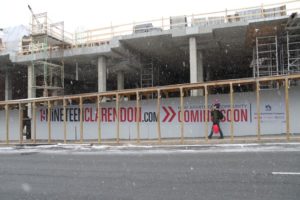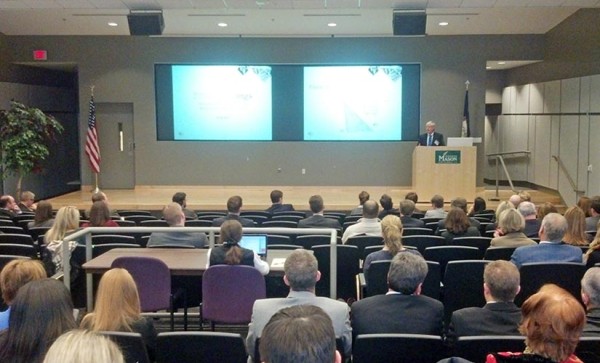(Updated at 12:15 p.m.) BRAC and federal cuts are a drag on Arlington’s real estate market, but Tysons Corner will not be as competitive as some in the county fear, according to Arlington Economic Development (AED).
The county agency gave its annual real estate market review and forecast to a group of developers, property owners and local leaders on Monday. This year’s presentation was titled “Silver Line-ings,” after the new Metro line that is expected to open within a year and bring increased economic development to Tysons.
“I’m not freaked by Tysons Corner,” said AED Director Terry Holzheimer, adopting a bit of youth lingo.
“I don’t think we’re going to see a big negative from Tysons,” he continued. “Arlington will continue to be a better place. Arlington will continue to have better product. Arlington will continue to be highly competitive to Tysons Corner.”
Holzheimer said Tysons will “never catch up” with the kind of walkable, high-density, high-amenity urban corridors Arlington enjoys, and will continue to suffer from traffic problems. Plus, Holzheimer pointed out that commercial property taxes in Tysons are higher than Arlington. He said there’s “not a chance” of Tysons becoming the region’s “new downtown” — as proclaimed by some — in the next 20 years.
 “Rome wasn’t built in a day, and neither will Tysons be,” he said.
“Rome wasn’t built in a day, and neither will Tysons be,” he said.
Still, Arlington is facing challenges.
Office vacancies are up as the federal government makes cuts, plays hardball with office rental rates, and as BRAC continues to pull military offices out of Arlington. While BRAC was supposed to end last year, Holzheimer said Department of Defense office moves are expected to continue for the next three years, on top of the 17,000 employees that have already moved out of Arlington due to BRAC.
“It’s not even close to being done,” he said. Another 65 office leases in 25 Arlington buildings are expected to be impacted by BRAC in the next few years.
As a result of BRAC and federal cuts — “this malaise we’re in” region-wide — Holzheimer said office vacancy in Arlington has increased to 16.1 percent. Whereas Arlington usually has a lower-than-average vacancy rate for large central business districts (we’re between Boston and Houston in terms of office square footage), he described the county’s current vacancy rate as “middle of the pack” for the first time in a long time.
Interestingly, office rent in Arlington has remained high. The average per-square-foot “asking rate” is $41.13 in Arlington, compared to $18.93 in Dallas, $26.10 in Philadelphia, $31.54 in Chicago and $48.52 in the District of Columbia.
Another factor that makes doing business in Arlington more expensive than some parts of the country is a tight labor market. With unemployement at 4.1 percent in Arlington, Holzheimer said there’s a “labor shortage” in the higher-end of the professional/business services job category. That has made hiring more expensive for local companies. Holzheimer suggested that the country’s current restrictive immigration policy is also “a challenge” for Arlington companies in terms of recruiting high-skill immigrants.
Despite the various challenges, developers continue to build new office projects in Arlington. The office development pipeline includes 1.6 million square feet that’s under construction, 2 million square feet expected to be built soon, 2.2 million square feet approved but on hold, and another 3.7 million square feet making its way through the zoning approval process.
Office buildings account for about half of the county’s $1 billion tax base, compared to 25 percent of the tax base in Fairfax County, according to AED. While some have voiced opposition to certain office projects, Holzheimer suggested that Arlington residents should be grateful for office development, which helps relieve some of the tax burden from homeowners.
“That’s a great position to be in,” he said. “Commercial taxes are very important to us. We must support our business community. We could not fund our high-quality school system on the residential base alone.”
 On the residential side, Arlington is “actually doing pretty well,” Holzheimer said.
On the residential side, Arlington is “actually doing pretty well,” Holzheimer said.
Home prices continue to rise and homes are selling for higher than asking price.
“Right now there’s not enough homes on the market to meet demand,” Holzheimer said. “That’s not good news for affordability, but it is good news from a fiscal standpoint for the county.”
Residential development is continuing at a good clip. Currently, about 3,294 new residential units (mostly apartments) and 157,000 square feet of mixed-use retail space is under construction. Another 2,316 housing units and 62,000 square feet of retail has been approved but is not being built yet.
Holzheimer concluded by saying that while Arlington cannot control the overall real estate market, there are some factors within the county’s power.
“We can control taxes, we can control regulations, and we can control incentives,” he said.
Photo (middle) by Wolfkann


